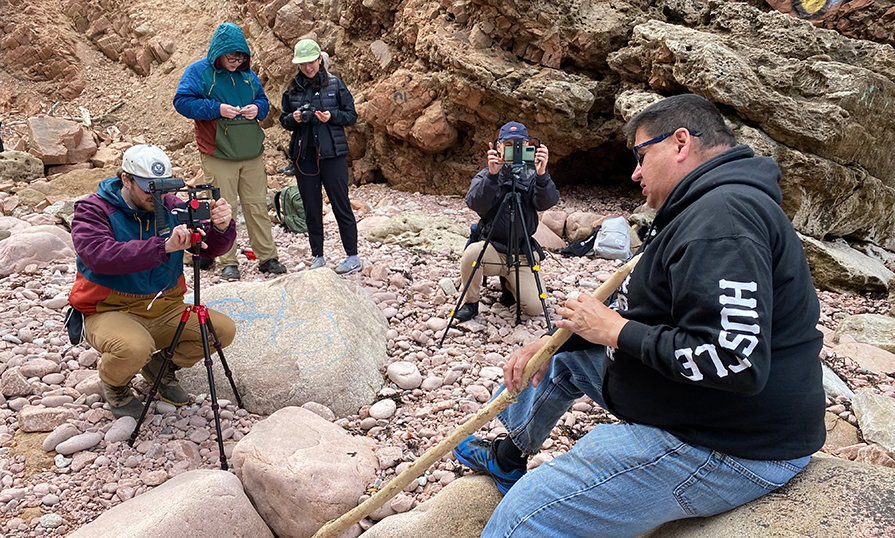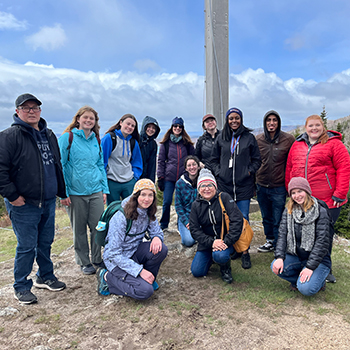Responsible reporting

Responsible reporting
When the Truth and Reconciliation Commission called upon Canadian journalism programs to incorporate Indigenous education into their curriculum, NSCC Radio Television Journalism Faculty member Erin Moore knew she needed to respond. After consulting with Duncan McCue, an Anishinaabe journalist, who frequently helps journalists report on Indigenous communication, Erin gained valuable insights into various approaches taken by different institutions on how to respond to the call to action. Erin then made the decision to develop a course that would immerse students in Mi'kmaw communities.
The course, Reporting in Mi'kma'ki, was initially developed by King's professor Terra Tailleur, who has since stopped teaching. In 2023, the course was co-led by Trina Roache, a member of the Glooscap Mi'kmaw community and an award-winning journalist with expertise in Indigenous reporting, alongside Erin who contributes from NSCC. Students from NSCC have been taking part in the course since 2022.
The course includes two weeks of learning in community and for the past two years visited Eskasoni, the largest Mi'kmaw community in the world. In the future, the instructors hope to take students to other Mi’kmaw communities.
Source: Annual College Milestone Enrolment Count
Community engagement and giving back
While the course was in Eskasoni, George Paul, also known as “PR George,” has been their Community Liaison. He works with the students and creates a daily schedule of activities and events. George has a journalism and public relations background and has been writing stories about his community of Eskasoni for nearly 25 years. He says he loved the idea when he first heard about the course and couldn’t wait to be a part of it. “Reporting in Mi’kma’ki is a beautiful program that incorporates the Mi’kmaq culture into its curriculum. The student is educated and enlightened by the beauty and the history of the Mi’kmaq, which, in turn, forms an appreciation and empathy of what it is like to walk in the moccasins of the Mi’kmaq,” says George. “For me, playing a major role in this course has been an honour. I take great pride in taking these young, non-Indigenous minds and showing them my experience as a Mi’kmaq reporter but more importantly, showing these students my people and my culture.”

Having someone from community guiding them while they’re there was an important part of the course. “George has been amazing,” expresses Erin. “He was essential to our success in Eskasoni.”
While in community, students aren’t just conducting interviews and producing stories; they spend time meeting and interacting with people and learning from Elders. “We talk about the four R’s - relationships, respect, responsibility and reciprocity, so that idea of giving back,” says Erin. In the first year of the course, they participated in a community cleanup and the following year, they spent a full day at the high school working with students and helping them learn the skills to interview Elders from their community. “We do that because we want to give back to them while we're here because they are giving us so much,” she adds. “It was incredible – such a powerful learning experience for all of us.”
Using best practices
Mitchell Ferguson, a Radio Television Journalism (RTJ) graduate, took part in the Reporting in Mi’kma’ki course in May 2022, just weeks before graduating in June. “I went into the RTJ program with a career in mind. I wanted to be a reporter, a journalist in Atlantic Canada in Mi’kma’ki. I thought it would be invaluable to know best practices,” he says. Today, he works as the Indigenous Affairs Reporter at the Cape Breton Post, using those best practices daily. “I think I described it at the time as the most profound learning that had happened during school,” says Mitchell, noting that the practical learning that NSCC is known for is amplified during this course.
Empowering through understanding
Erin states that the goal of the course is to encourage students to feel at ease when reporting on Indigenous stories, rather than refraining from covering them. “It's human nature that if we don't understand something, we can avoid it. No one ever wants to get anything wrong, but instead of trying, there can be avoidance,” points out Erin. “By increasing people's comfort and understanding by meeting people and connecting with them, there's something very powerful about what happens in terms of your growth as a human and your growth as a journalist.”
As a long time journalist and program faculty, Erin says she is thankful to take part in the course. “When it comes to the experiences of spending time in Eskasoni and participating in all these cultural events, I am learning along with the students. There's been a huge growth for me as an instructor and I have already brought it back into other classes,” she says.
A network of support
Erin says the course’s success at the College is a testament to the incredible support she received when first taking part in Reporting in Mi’kma’ki, including the NSCC Foundation, which funds the course for NSCC students. “We compensate any experts who are just meeting with us for their time,” she says, noting that they meet with a lot of experts in the four-week course. “We also didn't want to make money a barrier to the students who wanted to have this experience. So right now, it doesn't matter what socioeconomic background you come from as a journalism student at King's or NSCC, if you want to take this program, you can because it is fully funded. We could not do it without the funding from the Foundation,” she adds. The support, encouragement and enthusiasm I've found from the Foundation about this program has been exciting and a little bit surprising because I know I was proposing something that we've never really done before, but there wasn’t any hesitation.”
Valuable learning
Mitchell believes the course should be mandatory for all journalists – even if they’ve already graduated and are working in the industry. “It's invaluable information,” he states. “I think a lot of the reporting around issues would be better if everybody had the chance to take it.”
Erin says media organizations look at this knowledge as valuable when considering who they should hire. “Every organization wants this type of experience and teaching. There is an awareness and appreciation of [the Reporting in Mi'kma'ki course] within the industry because they are trying to do the same thing within their own organizations,” she says.
Mitchell notes that his experience from the course gave him the confidence to apply for his current role as an Indigenous Affairs Reporter. “I feel really good that I have a career that I feel comfortable and fulfilled in. I feel like I made the right choice.”

